In June 1970, members of the Trumpington Women’s Institute produced an album titled The Countryside 1970, Trumpington, with information and photographs about the village and its environment. Some additional details were added in later years. The report is reproduced here (June 2020), 50 years after its original publication, with thanks to the Women’s Institute. For information about the Women’s Institute, see its history and photographs from its archive.
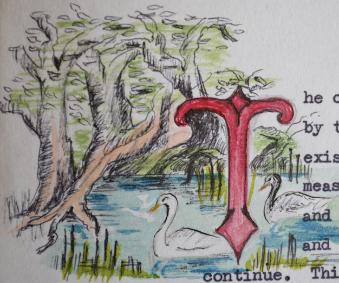
All text and illustrations from The Countryside 1970, Trumpington . See end of report for authors’ names.
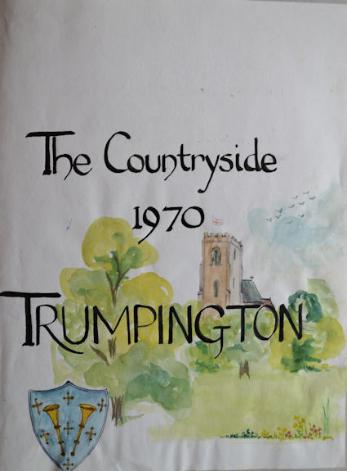
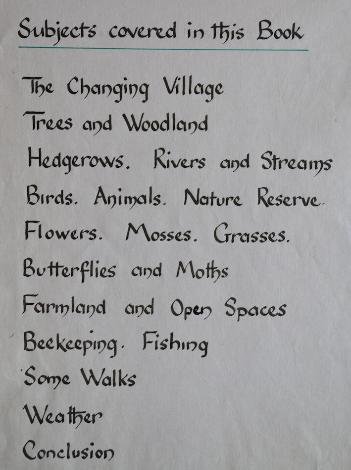
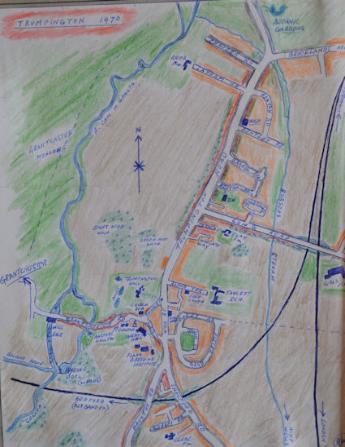
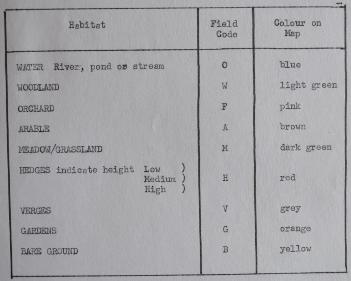
The Changing Village
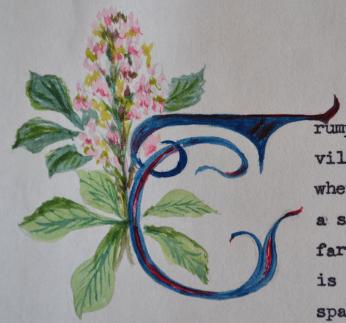
Trumpington has changed! Strictly we are no longer a village because in 1932 we officially lost our identity when we were incorporated into the city area and became a suburb of Cambridge. However, Trumpington is just far enough out of the city centre and, more important, is separated from the town by about two miles of spaciously developed tree lined road, which by law must remain that way, that we are able to retain some of the characteristics of a village. But these at first sight are not noticeable to the 1970 traveller into Cambridge or the morning and evening commuter from the Shelford direction as he joins the nose-to-tail queue of traffic through the village.
Commencing his crawl just within the city boundary, he can study the neat suburban houses – many different styles and ages – each with a slender dividing fence or hedge, a neat square of lawn and most certainly some variety of rose bush or climber. Over the bridge, crossing the now dis-used Bedford railway line, closed in 1968, 106 years after opening in 1862, he will have time at the traffic lights, if it is May time, to admire the pink and white horsechestnuts in the narrow belt of woodland edging the Plant Breeding Institute’s Experimental Fields. The Institute’s buildings have grown apace in the last few years and are fast approaching large factory proportions …. Miss Newman of Toll Bar Cottage remembers childhood visits to her Aunt when these fields were parkland and grazing for the horses kept at Anstey Hall, when baskets of walnuts could be picked up in the Autumn and mushrooms in plenty to add variety to the day’s meals. Not so long ago these fields stretched away in an unbroken view to the west and one could watch the sun set in a blaze of colour. Now the skyline is blocked and the view closing in.
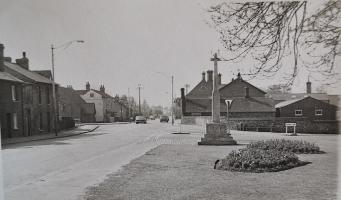
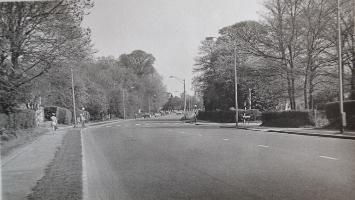
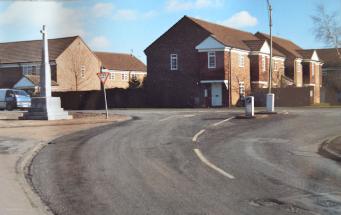
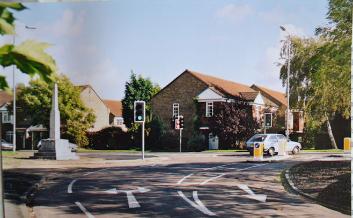
Passing the “Weighbridge” and “Toll Bar” cottages the driver will note the time on the clock on the new “Bidwell’s Offices”, pass the Petrol Station, side-by-side with an old thatched cottage, the “Red House”, the new Whitlock’s Old People’s Home, a medley of Victorian cottages, a block of four modern flats and the village smithy turned carpenter’s shop. Then there is the War Memorial, on the site of “Cross Hill”, still the scene of a Service of Dedication at the time of the “Two Minutes’ Silence”. Next are several old thatched cottages, in a sad state of repair, and the early 17th century “Coach and Horses” where we hear Prince Charles enjoys a drink, and the driver is out of the village and on to the wider road, edged with a belt of copse and a variety of stately trees, sheltering what the estate agents would call “most desirable residences”. Over to the left are acres of arable land; it is not spectacular scenery, but stand for a minute some time and look over towards Newnham and Orwell Hill and it is as pleasant a country view as one could wish to see.
Coming back from Cambridge, the approach to Trumpington has not altered much over the years beyond the addition of Porson Road, once a field which for a few years anyway produced a veritable Flanders field of scarlet poppies. The Perse Prep. School, once Leighton House, stands back on a rise of ground, the green lawns, seemingly unharmed by football and cricket pitches, sloping gently towards the road. This piece of parkland contains many beautiful and unusual trees, not least important being the horsechestnuts which have provided a happy hunting ground in autumn for many a generation of boys and girls who love collecting bags full of “conkers”. Past Wingate Way, another post-war development, we come to the oldest house in Trumpington, the 15th century “Green Man” with its attractive “Robin Hood” style inn sign. Past “The Red Lion” and some grey slated, white brick cottages already scheduled for demolition, we come to the crescent of shops and flats; notable here is “Trueloves” where everyone stops for sweets, ices and the “Cambridge News”. Behind this block lies the 1945 Council Estate; how many remember that little more than twenty years ago this was a meadow, bright with buttercups and daisies in the Spring, the village Recreation Ground, with an uninterrupted view over the fields leading up to the wood-clumped chalk Gogs.
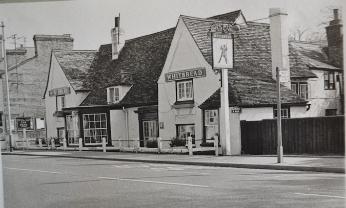
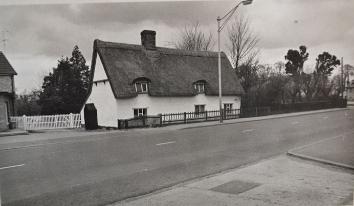
But here let us make a detour and get a glimpse of the original village of Trumpington. Turning down Maris Lane we pass on the left Anstey Hall, now used for Government Offices, but recently the home of the Foster’s Bank family. “Maris House” is opposite – a picturesque, wisteria covered old farmhouse built about 1800. Round the corner in Church Lane, which leads back to the village high street, is “The Old House” – really old – being an early l7th century house in rich red brick and showing the Dutch influence in its construction. Opposite is the Old School and School House and among the row of cottages, our oldest – 1634 – now being restored. On the left is the Church of St. Mary and St. Michael, set off by majestic trees and an immaculate Churchyard. The moss on the churchyard wall is a very special variety, Tortular Muralis and the local Naturalist Trust Society have asked the Vicar to see that it is not removed, even at the expense of damage to the wall. Standing at the north door, one can look across the parkland of Trumpington Hall and catch a glimpse of the four towers of King’s College Chapel. Here, with the birds singing on a summer morning – the soft cooing of the pigeons, the occasional squawk of a pheasant in the copses leading down to Byron’s Pool, is the time and place to “stand and stare” and enjoy the tranquillity of the countryside.
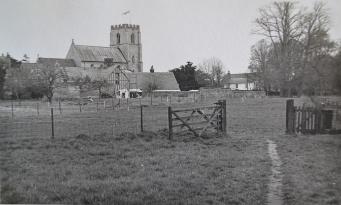
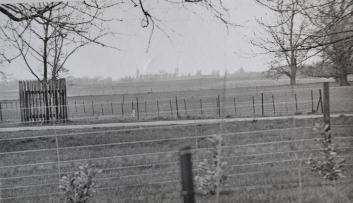
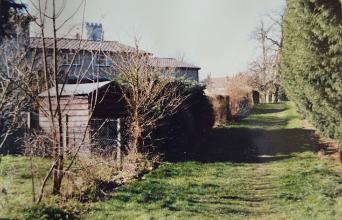
How important it is in this day and age to preserve some of our countryside, the wide open spaces, the quieter roads and footpaths, the rivers and streams, field, hedgerow and wood, where lives a world within a world – a community of trees, shrubs and undergrowth each with its dependant birds, animals, insects and flowers. At a time when there is increasing leisure and cars everyone is looking for a quiet country spot to relax, whether it be to camp, to picnic, to walk or swim or sail, for the pursuit of hobbies or to study Nature itself or, like Rupert Brooke, to
…………………………………lie
Day-long and watch the Cambridge sky,
And, flower-lulled in sleepy grass,
Hear the cool lapse of hours pass…..
Here in Trumpington we hope to do just this, i.e. preserve some of the countryside, and for those with eyes to see, ears to hear and feet to walk there is much to enjoy – as can be found in the following records made by a few Trumpington people. We know these records must be far from complete for undoubtedly there are many people with a keen interest in natural history who could have supplied us with a wealth of information if we could have contacted them.
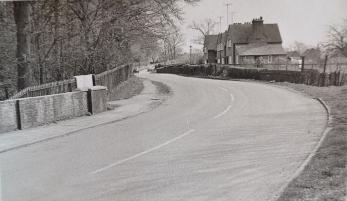
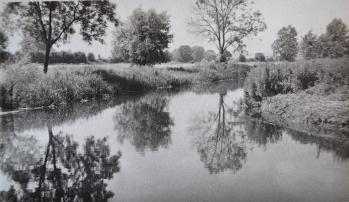
Trees and Woodland
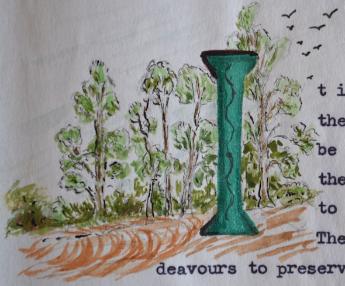
It is most desirable, in an urban environment, that the best of the natural features of the area shall be retained when development is taking place. In the case of trees, these can often be landscaped in to the building, and will always improve the amenity. The Planning Department of the local authority endeavours to preserve as far as possible existing trees etc. where building development allows, but it is the local population who is the best able to keep a watchful eye on what is worthy of preservation. Representation may be made to the department by anyone who considers some area, tree or building to be noteworthy. Some examples of where post-World War II development has gone hand-in-hand with preservation are at –
Wingate Way, where trees have been retained at the Trumpington Road end.
Gilmerton Court, at the corner of Long Road and Trumpington Road where the local residents protested that too many trees were being sacrificed, before a halt was made.
On Long Road, where 24 large chestnut trees fronting the Telephone Exchange and the new houses (Rutherford Road) remain and are an imposing sight and a delight when their tall candles of bloom stand out against the fresh green foliage.
On the High Street, where the footpath was widened to accommodate a bus lay-by, and an Acacia tree from what was formerly a nursery for rock plants has been preserved and is now on the footway.
The New Estate. On completion of the building, the approach was laid out with broad grass verges and planted with various trees.
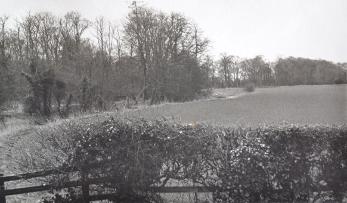
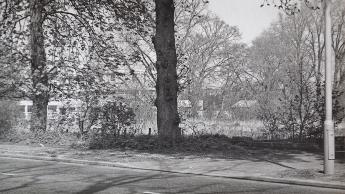
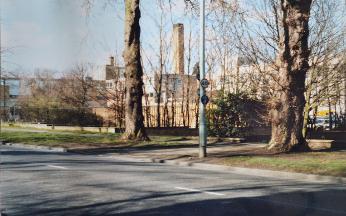
Good husbandry combines a facility in creating a productive industry within a pleasing environment. The farmers in Trumpington, highly mechanised in these days, seem especially aware of preserving what contributes to man’s aesthetic enjoyment. The broad belts of woodland, of sycamore, elm, ash, elder and hawthorn which extend along the highway into Cambridge, and in Long Road as far as the A604 are evidence of this concern, and it is to be hoped that these plantings will be preserved by succeeding owners. Like the hedgerows they provide a habitat for birds and small creatures, whose existence is being increasingly threatened by urbanisation and high pressure farming methods.
A belt of woodland, somewhat different in character, extends along the Hobson’s Brook. Here are chestnuts, beech, silver birch, elm and pine, with hawthorn on the field side.
Two woods 13 acres in extent stand on the north-west of the Park, and comprise elm, oak, beech, silver birch, walnut, elder and horse chestnut.
In the Park are four or five large oaks, six limes, horse chestnuts, Sweet chestnuts, ash, walnuts, two or three Sycamore, copper beech, two wellingtonians, and two Lebanon cedars. Further plantings of poplar, cypress and laurel are being made at the present time.
An area of woodland extending on both sides of the river Cam near Newnham is known as Paradise, and elm, ash and willow are to be found. There is an osier bed to the south of Paradise, but the reeds have not been systematically cut for a few years.
In the churchyard are three Yews and several clipped yews, one pine, one cedar and three cypress. Nearby Anstey Hall farm has a fine mulberry, planted c.1910. The bole of this tree has been the site of a spotted flycatcher’s nest for several years, and a brood safely hatched in 1969.
Some exceptionally well-grown beeches, both copper and green, with elm, holly, chestnut, pine and yew, make an imposing foreground to Anstey Hall, now housing Government departments.
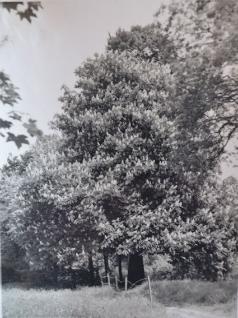
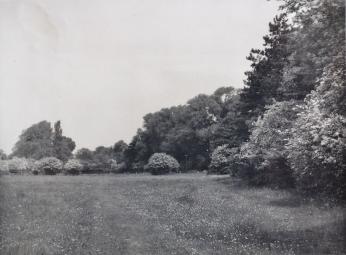
The Countryside – Trumpington – 1982 update
The most dramatic change in the face of the countryside since 1970 has undoubtedly been the loss of elm trees. Whole woods, groves and parklands right across the country have been stripped of these beautiful generations-old trees through Dutch Elm Disease. The virus, carried by a bark beetle, is thought to have entered this country early in the 1970s in timber imported from Canada into Bristol and Liverpool. So it was estimated in 1981 that 13 1/2 million elm trees have been lost through the disease in the last decade.
At the time the survey of Trumpington countryside was compiled Dutch Elm Disease was just taking hold in the West Country. However, a report in the Cambridge Evening News in September 1971 was headed – “Cambridgeshire escapes worst of elm disease. We are not worried about the situation in the County. Affected branches are lopped off as soon as the disease is noticed and all measures taken have so far proved effective.” By October 1972 – “only one city-owned elm had been felled because it had elm disease.”
Thereafter the scene changed rapidly. A survey conducted in September 1975 showed that elm disease in Cambridgeshire was “virtually uncontrollable. 5,000 elms had been affected, a number which could be up to 20,000 in two years’ time and that it would be at least half a century before the landscape could recover.” In 1978 the loss in the County was about 50,000, the effect of the virus having been accelerated by several hot, dry summers and exceptionally strong winter gales which took their toll of weakened trees. To sum up – a 1981 Cambridge Evening News headline read – “Elm trees will soon be a memory in the city’s parks.”
So the scene in Trumpington has changed too. Gradually the diseased elms in Anstey Hall grounds have been felled and the loss of large numbers along Trumpington Road and Long Road has left wide open spaces. Perhaps the most noticeable loss was the Grantchester Road Plantation of the Pemberton Estate, while Byron’s Pool woods have been reduced to near coppice thickness. However, extensive tree planting of mixed varieties has been undertaken by the Plant Breeding Institute in their area and by the City Council along Trumpington Road and Byron’s Pool.
Mr. Antony Pemberton, Director of Trumpington Farms, has given details of the tree planting programme carried out on the Pemberton Estate. All diseased and dead elms have been eradicated; suckers are growing up but he does not consider these will produce disease-free trees and will have to be removed. He estimates that since 1970, 30,000 young trees have been planted on the Park estate and farmland, a riverside plantation by the Cam beyond Byron’s Pool weir, and in random groups on the slopes rising each side of the new M11 motorway. The trees are mixed – oak, ash, lime, beech, chestnut – a close river-bank planting of willows and protective screenings of laurel and cypress; some are new areas and some replace the areas of fallen elms. He recommended several points from which photographs could be taken now to make an interesting comparison of the scene ten years hence.
Trees
The following is a list of trees in the grounds of the Perse Prep. School at Leighton House, Trumpington Road, sent in by Miss B. Carmichael.
Tree of Heaven
Cedar of Lebanon
Deodar (Indian Cedar)
Giant Silver Birches
Large Monkey Puzzle
Large Japanese Maple
(15-20 feet)
Wellingtonias (2)
Lime – Linden, Huntingdon, Darker green, silver backed leaf
Spindle
Horsechestnuts
Sycamores
Scots Pine (2)
Turkey Oak
Beeches (2)
Copper Beech
False Acacia (Locust Tree)
Weeping Ash and Varigated Holly behind the school
Belt of trees along Hobson’s Brook in leaf June 1970
Elder
Larch
Black Poplar
White Beam?
Chestnut
Pine
Silver Birch
Beech
Lime
Sycamore
Willow
Alder
Ash
Hawthorn
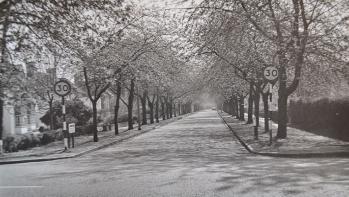
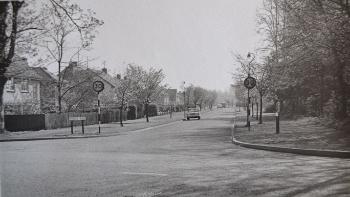
Hedgerows
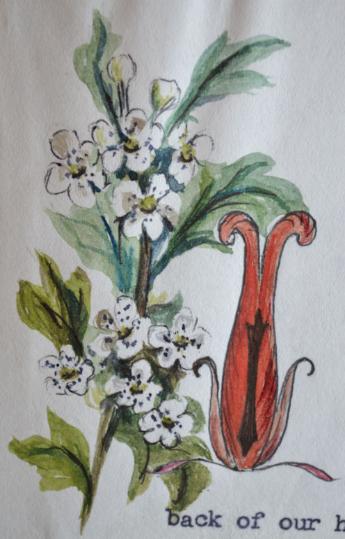
Is there a lovelier sight in May than a hedgerow tumbling with hawthorn blossom? It is certainly becoming an uncommon one, and those of us remembering the countryside between the Wars (1914-18 and 1939-45) deplore the uprooting or drastic cutting of our hedgerows. East Anglia has probably suffered more than any other region in this respect. Hedgerows were originally planted for demarcation, shelter, and to enclose stock, and they incidentally provided a reasonably safe habitat for birds, insects and small animals. With the growth of farming into the highly organised and mechanised industry it is today, the farmer has looked around to see that every available piece of land is brought into production, and hedgerows have suffered alarmingly as a result. There is welcome evidence that not all farmers have gone along with this system, and the idea is increasingly being held that the depredation has gone far enough, and that an effort must be made to counter one of the results of a hedgeless landscape – soil blowing. The Council for the Preservation of Rural England is one organisation which is active in using its powers of persuasion to inform and enlighten on this matter.
In spite of the increasingly urban nature of Trumpington, there remain some hedgerows which are allowed to grow in the old manner, to the delight of the walker, and I am sure, of children, noteworthy are those on pasture land to the east of Bishop’s Road and at the rear of gardens on Hobson’s Brook side of Newton Road.
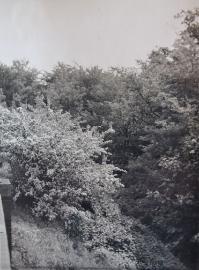
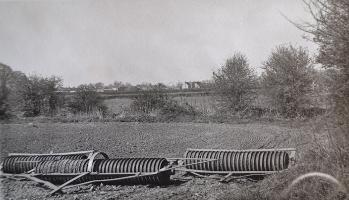
Rivers and Streams
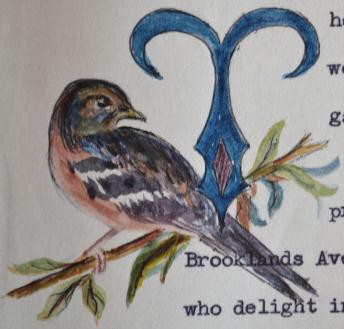
The River Cam marks the boundary of Trumpington on the western side. The flow of water is controlled by sluice gates at Byron’s Pool and at Grantchester Mill.
The Hobson’s Brook, to the east of the village, provides a pleasant and popular country walk as far as Brooklands Avenue. It also provides endless scope for small children who delight in wading in its shallows, fishing for minnows and other small fry, or getting from one bank to another by seemingly perilous manoeuvre on the overhanging willow trees. Water Milfoil and Canadian Pondweed grow here, and the Bullhead fish which breeds at Nine Wells can be found under the old stone bridge. The Kingfisher is occasionally seen, and in a hard winter the snipe. Both birds were observed in 1969/70.
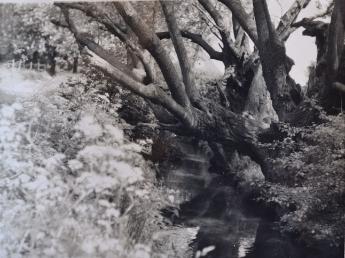
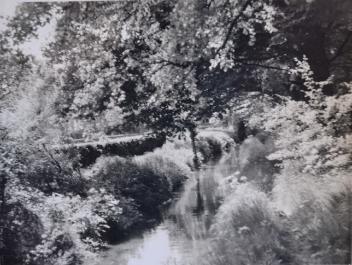
Although the area Nine Wells is just outside the south eastern boundary, it is felt it should be mentioned as it is the source of Hobson’s Brook. The following description is taken from the List of Nature Reserves published by the Cambridgeshire and Isle of Ely County Council.
“Nine Wells. Chalk springs surrounded by tall thorn bushes. The springs contain a number of interesting animals including the Planarians, P. Cornuta and P. Alpina, relics of the glacial period, as well as a Trichopteran, Agapetus fuscipes, which was more widespread during the Atlantic period. The springs also provide a breeding ground for a small fish, the Bullhead, Cottus gobio. The site is most widely known as the source of Hobson’s Conduit.” The density of the bushes round the spring is controlled so as to avoid eliminating the animal population.
A deep ditch and driftway extends southwards from River Farm and gives security to breeding mallard, and is the haunt of heron, coot and moorhen.
Birds
Here is a list of Birds seen in and around the gardens of Trumpington during 1969/70.
Fieldfares
Bramblings
Cuckoo
House Martins, normally several nests on Anstey Hall Farm, but curiously absent in 1969.
Swallows
Swifts, exceptional number seen by Mr Parsons in 1969.
House Sparrows
Hedge Sparrows
Starlings
Blackbirds
Song Thrushes
Mistle Thrushes
Blue Tits
Great Tits
Gold Crests
Robins
Pied Wagtails
Wrens
Crows
Chaffiches
Bullfinches
Lapwings
Sky Larks
Gold Finches
Jackdaw
Barn Owl
Little Owl, seen in Willows by river just south of Byrons Pool.
Brown Owl
Pigeons
Kingfisher, appeared on Hobson Brook for the first time since the hard winter of 1962.
Woodcock
French and English Partridges
Pheasants, not artificially reared at River Farm now. Also seen at Clay Farm. One nest in
garden at Gazeley Road.
Kestrel, seen at the Royal Show ground.
Coot
Jays
Rock Doves
Turtle Doves
Seagulls
Green Woodpecker )
Greater Spotted Woodpecker) all seen at Gazeley Road.
Lesser Spotted Woodpecker )
Green Finches, seen in Hauxton Road.
Fly Catcher
Meadow Pipit
Tree Creeper, seen in Woodland bordering Grantchester Road.
Sparrow Hawk )
Carrion Crows ) seen in River Farm.
Magpies )
Heron )
Little Grebe
Moorhens ) nest in ditch at River Farm.
Coot )
Water Rail
Mallard
Teal
Mute Swan, nest at River Farm
Snipe
Golden Plover
Rookeries are to be found in Grantchester Road (five nests) and Long Road (eleven nests).
Mrs Ginn writes an interesting account of her friendly owl –
“Save that from yonder ivy-mantled tower
The moping owl does to the moon complain
Of such as, wand’ring near her secret bower,
Molest her ancient solitary reign.”
The owl in “Gray’s Elegy” had little cause to complain for she did not have to contend with the swift encroachment of her nesting and hunting places by expanding villages and towns.
It was all the more pleasing when about two years ago while walking in my garden after dark a barn owl swooped past me to alight on a tree nearby, on closer inspection it seemed somewhat distressed but showed no fear. I returned to the house but later I crept out again to find it still there. Now as with all strays it seems a natural reaction to give food and this I did, namely liver on which I feed the cat, added to which I combed a few hairs from her beautiful long coat to wrap round the said liver. A likely tale you might think but it worked and the owl soon got the message. Of course I am not fooled either, I know the regular visits are for tit-bits, but it gives me great pleasure even so. I understand they mate for life and at a guess I would think he or she had lost its mate (I don’t know the sex of my owl) and this would account for it being a loner.”
Contributed by Mrs Moffatt, Achray, Gazeley Road. –
My son returned from a walk across the fields adjoining our house late one evening in the middle of May a year ago, carrying what appeared to be a small ball of dirty cotton wool. “This” he informed me “is a baby owl – I found it in a puddle under a tree”. We doubted if it would survive the night: however, it was able to eat some minced beef and was obviously in dire need of food. Next morning it had another meal and from then onwards it developed a healthy appetite. Hand- fed on an all-meat diet every few hours it thrived, improving from day to day.
It grew rapidly, became quite lively and very tame. Its home was a tea chest with wire netting over the front. Even though at this stage it was a harmless baby, the smaller birds hated it, “dive bombing” it and squawking loudly when it was on the lawn.
As it was making brief attempts at flight, the tea chest became too small, so a large cage about the size and height of the garage which it adjoined, was built, with perches and a tree conveniently at one end. He lived with us until the end of September, growing into a very handsome, beautifully marked tawny owl. He was very sociable, flying straight to my son’s or my husband’s shoulder as soon as they entered the cage. He sheltered under an old umbrella on wet days, sunbathed on top of it, wings outspread, and he loved a bath on warm days.
Eventually he began sleeping during the day and being very lively in the evenings, getting more owl-like and losing his “human” habits as time went on – but always very independent. He had progressed to a diet of rabbits and mice which my son provided for him – neither very easy to find. At the end of September we let him free, and at first he would come into the house at every opportunity, living in the near-by trees. He was extremely curious; if he saw our son through an open window he would fly in to see him. He grew more venturesome, disappearing from time to time, but always came to shout for his supper about 6.30 p.m.
After six weeks of freedom he suddenly vanished; we neither saw nor heard him for a fortnight. We were afraid some harm had befallen him so we searched everywhere, calling him at dusk – but no sound or sign. The garden seemed empty, and we missed him greatly. Our son came home for a week-end from University, arriving shortly before midnight, making his owl calls as he came up the drive, and to our great joy “Enoch” answered from the trees nearby! The next morning he flew down on to Alex’s shoulder when called, but that was the last time he made contact with us. We heard him on the odd occasion, but it was so good to know that he could fend for himself, also that he had evidently made friends with other tawny owls – or one particular one which used to visit him when he lived in his cage.
Animals
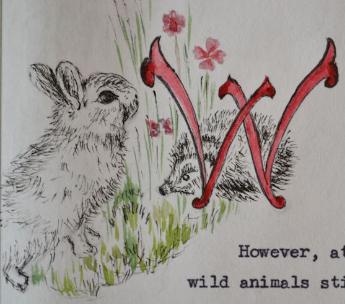
With the exception of a fine herd of 70-80 cows at Martin’s Glebe Farm, and occasionally pigs grunting in a farm field, the only animals seen about Trumpington are cats and dogs and even these are becoming fewer because of the busy roads and therefore danger to both animal and motorist.
However, at odd moments one can get a glimpse of some of the wild animals still left to our countryside. Like the rest of England we lost our rabbits with myxomatosis and only the occasional one crosses our path, but they are re-establishing themselves and it is said the new generations of rabbits no longer burrow but tend to live like hares.
A few years ago families of hares frolicked in the fields behind Bishops Road, but these have gone, though they are reported to be still in the Park woods and at the other village farms, where they are looked on as a menace to young Sugarbeet crops. Three fox’s earths are known in Trumpington. Badgers visit Anstey Farm, but there is no known “set”.
In their secret hide-outs hedgehogs still breed in plenty and sadly many of them feel they must cross the roads at night in the path of cars for we often see their flattened bodies the next day. This may soon be an unusual sight as, according to a recent magazine article, it has been observed that hedgehogs are developing an instinct to run instead of curl up when danger threatens. The following observations were made by Mrs Ginn of Bishops Road –
“My permanent residents are the Hedgehogs, they have had a nest in the garden for many years and I am quite sure following generations take over the happy home over the years, and they like all creatures never say no to a regular meal.
During early spring I always keep a look out each evening for the first appearance of the two I presume to be Mum and Dad. Nature then takes its course and within a very short time the young ones appear for their first foray. I start first by leaving food near the nest and after about five days have them dining near the house where I can watch their antics in comfort. One is not allowed to forget feeding time in these early days for if no food is put out there is usually quite a shindy on the shingle near the house. These delightful small creatures are not given to silent protest.”
As we have so many old trees in Trumpington there are still numbers of grey squirrels with us and they have been seen in many gardens along Trumpington Road – in the grounds of the Perse Prep. School – in the trees at Byron’s Pool and the Park woods. Some bold, mischievous ones dart down into Mrs Newell’s garden at Weighbridge Cottage to pick her strawberries and then brazenly sit on the wall eating them! Here, 20 – 30 years ago red squirrels were seen but the grey squirrels have replaced them. Few moles have been noticed but long tailed, and short tailed mice, shrews, brown rats, stoats and weasels inhabit the copses.
Hobson’s Brook and the river bank are still quiet spots, so the usual riverside voles and water rats can be seen if one sits waiting quietly enough for the sight of a bright eye and twitching snout to appear from a dark hole amid the lush green river vegetation. There is evidence of otters (dead fish etc. on the bank) but they are very shy and have not been seen. Here and in gardens frogs and toads have been seen and few homes can have escaped having the Springtime jar of tadpoles added to the family.
Private Nature Reserve
Gazeley Lane, running parallel and next to Long Road, could be said to have changed very little from what it was when Trumpington was still an agricultural village. Along its verges the wild violet and the campion still grow, the aconites have crept under the trees and Queen Anne’s Lace – so much prettier a name than Fool’s Parsley – riots in abandon in May time.
The mouselike tree-creeper is a frequent visitor, seeking the insects bedded in the trunks of prunus and pine. The blackcap and warbler are common sights and we have seen the flycatchers swooping low over the lawn. And one pair of parent swallows demonstrated to their young brood exactly how to do that wonderful diving flight by taking off from the clothes line. The youngsters seemed so surprised when their own dives took them too low to skim, and they found themselves floundering on the grass!
But for one pair of long-tailed tits there was tragedy. Their beautiful pouchlike nest had been built high in a pine tree safe from marauding creatures. But not, alas, safe from a blustery high wind accompanied by rain. The nest was blown out of the tree. And although we tried to wedge it in a lower branch, the wind defeated our efforts. Red-clawed Nature seems sometimes unaccountably cruel.
The summer evenings bring the bats, wheeling soundlessly in their search for insects. And the hedgehog emerges. To a now established custom. One evening, as old Prickles snuffled across the grass, I took out a saucer of milk for him. Having decided there was nothing suspicious about it, he finished off the milk and sped – literally – into the hedge. The saucer was replenished. Next night he was back again and the performance was repeated – as it was on later nights. Except that the replenishings became more frequent. This mystified us for a while until we realised that we were providing for more than one hedgehog – at least three, in fact!
Something that cannot continue for much longer is the nesting of pheasants next door. The garden is greatly over-grown and for several years now has been the breeding ground for what was originally a pair of pheasants. It’s an awfully proud father that parades his family in spring. And pheasants on a snow covered lawn make an attractive winter picture. But perhaps they’ll just move their quarters into the woodland part of another nearby garden, so that we may still enjoy the sight of our own ‘home reared’ game birds. We all hope so.
E.M.C. [Edith May Carr]
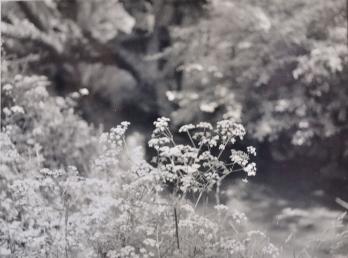
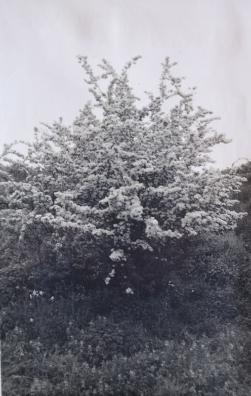
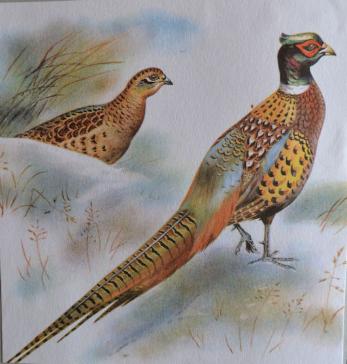
Flowers
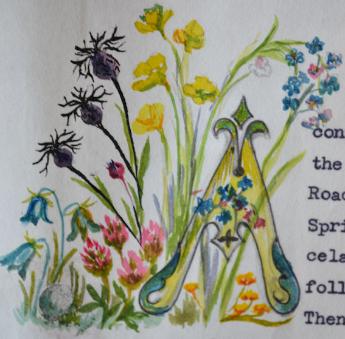
Aconites in the Plant Breeding Institute grounds, and the bright green foliage of the Cuckoo Pint in the Long Road spinney and elsewhere, are the first heralds of Spring. Coltsfoot, white and purple violets, and the celandines which carpet the ground in Byron’s Pool soon follow, with some bluebells away from the public walks. Then in swift succession appear the flowers common to a light gravelly soil, such as the buttercup, white and red dead nettles, hemlock, sow thistles, clover, knapweed, ragwort, common vetch, ground elder, and shepherd purse. In June, wild roses festoon the bushes along the Hobson’s Brook (sometimes known as Finch’s Walk), and later the rose bay willow herb throws up its tall spikes along the water’s edge.
Wild honeysuckle can be found in the Grove, and the wild sweet pea on the Shelford Road close to the abandoned railway line. The Pasque Flower is not too unusual an inhabitant of gardens in Trumpington, and it’s feathery wind-born seeds could easily take root on suitable sites outside, though there is no record of them in the wild. At River Farm, where the ground is low-lying and subject to flooding, the occasional orchid may be found; there are also cowslips, marshmarigold, meadow buttercup, forget-me-nots, ladys’ smock and bullrushes.
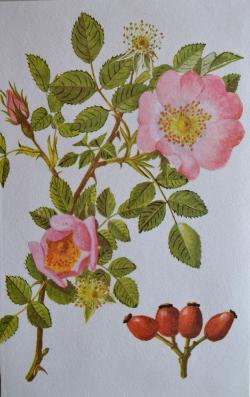
Wild flowers identified along the disused Railway line between Long Road Bridge and Shelford Road Bridge – in flower – 18th June 1970
Hogweed
Cow Parsley
Dock
Goat’s Beard
Knapweed
Dog Daisy
Heartsease
Tansy
Field Scabious
White Campion
Bladder Campion
Long-rooted Cat’s Ear
Common Ragwort
Poppy
Lady’s Bedstraw
Bindweed
Convolvulus
Speedwell
Willow Herb
Bastard Toadflax
Scarlet Pimpernel
Cinquefoil
Mustard
Plantain
Toadflax
White Bryony
Common Mallow
Herb Robert
Stinging Nettle
Sun Spurge
Spear Thistle
Figwort
Water Mint
Corn Mint
Yarrow
Hound’s Tongue
Scentless Mayweed
Hairy Tare (or Vetch)
Kidney Vetch
Meadowsweet
Mosses
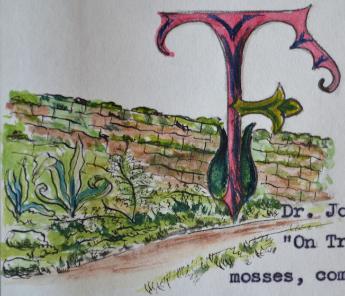
For the most part we think of moss as a velvety green carpet growing on old walls and in cool, damp woods – very beautiful, especially when it catches a gleam of sun. Some varieties are regarded as a nuisance plant which spreads insidiously over the lawn. Few people realise the Moss family is a kingdom on its own.
Dr. John Rishbeth has given us the following information –
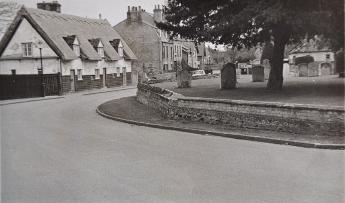
“On Trumpington Churchyard Wall there are six families of mosses, comprising 18 varieties, of which the best known is “Tortular Muralis”. At Byron’s Pool there are ten families, comprising 42 varieties, and families of Liverworts of 6 varieties. These particulars are taken from Dr. Whitehouse’s list compiled about five years ago. None is especially rare, but several are of interest in appearing in Relhan’s flora, dated 1810.”
Grasses
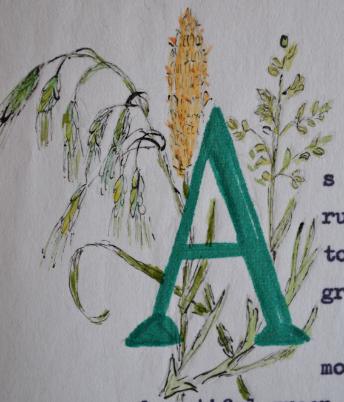
As Trumpington is more a suburban area than a true rural village, it would perhaps not be out of place to remind ourselves that grass is not just a green growth that has to be cut.
The grasses of our countryside form perhaps the most important part of the flora and provide the beautiful green of the landscape. There are several areas in Trumpington where it is possible to take a closer look and notice the beauty of each individual grass “plant”, the size and shape of which vary so much according to the type of land on which they grow. Apart from the value of grass as pasture and hay crop for animal feeding, its delicate spikes also have a decorative value, both in their June freshness and dried for winter floral arrangements.
The places where everyone can see some of the many varieties that flourish round Trumpington are the verges along Hauxton Road, Grantchester Road, Long Road and at Byron’s Pool, the Park and Hobson’s Brook. The following is a list of some of the most common to look for –
Annual Meadow Grass
Meadow Foxtail
Barren Brome
Barley Grasses
Common Cat’s Tail (Timothy Grass)
Couch
Cock’s Foot
Soft Grass
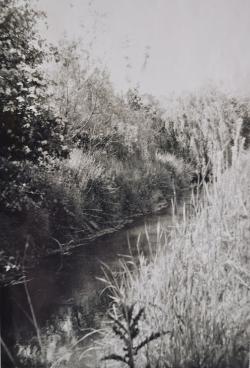
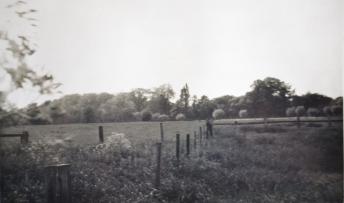
Butterflies and Moths
Butterflies and moths seem to be becoming an uncommon sight in Trumpington and very few of each species which like Trumpington soil and its plants have been noted during the year. Could this be the result of some severe winter weather in the last decade, the wet summers or the more prevalent use of chemical fertilisers and pesticides in garden and field? Or a combination of all three?
The following have been noted –
Brimstone
Peacock
Tortoiseshell
Red Admiral – in one garden up to a dozen were counted frequenting the compost heap rather than flowers and shrubs
Cabbage white – in plenty causing severe damage in late summer
Farmland and Open Spaces
The year 1970 sees five arable farms in Trumpington – Church Farm, Anstey Hall Farm, Clay Farm, River Farm and Glebe Farm. The approximate combined acreage of sowings for 1970 are – Wheat 100, Peas 125, Beans 135, Sugar beet 110, Barley 175, Potatoes 15, with 220 acres of grass and pasture.
The several Playing Fields to the east and west of Trumpington Road provide welcome open spaces, and it is hoped they will restrict the urban development.
The Plant Breeding Institute , situated at the corner of Hauxton Road and Maris Lane extends over 388 acres. However, because the management is strictly controlled for the purposes of plant growth and pollination (bees and other insects introduced for fertilisation are not free ranging), the area is not relevant to this report.
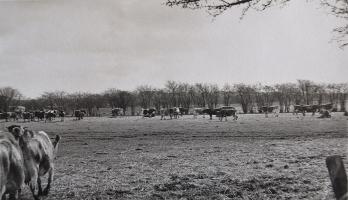
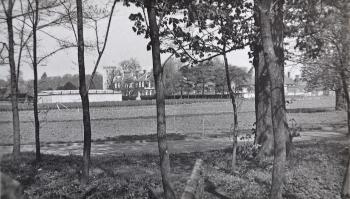
Coprolite Pits
Coprolite, a fossil dung, was dug on land off the Hauxton Road during the 1914-18 war, to provide phosphate. The excavations extend over approximately half mile, and there is now water to a depth of about 30 feet, and willow and alder on the banks. The isolation of the pits from human thoroughfare has made them a sanctuary for wild life, and pochard, mallard, tufted duck, coot, moorhen, heron and kingfisher can be seen.
To Bee or not to Bee
This report on Bee-keeping has been made by Mr Eric King –
“In 1970 are we to see a further decline in the Bee population of the parish? Facts must be faced, in the past ten years the number of apiarists has probably halved. This must be due to several tendencies, undoubtedly the use of local arable land for building purposes has removed rich sources of nectar that the Bee converts into honey; removal of hedgerows, and pest control with toxic sprays are often reasons for Bee Keepers either retreating into the wilds beyond the city boundaries or for economic reasons giving up their hobby altogether.
For three out of four years the bee keeper faces small yields for his pains and only occasionally does the weather allow collection of the surplus honey.
In conclusion, it would seem inevitable that this ancient craft becomes a mere memory whilst we will, perforce, supplement our breakfast with an imported adulterated apology for the real thing.”
Fishing
The fisherman casting a line in the Cam is likely to be rewarded with roach, perch, dace, pike, eel and the occasional chub and trout. Pike and eel are also to be found in the ditch at River Farm.
By Shank’s Pony
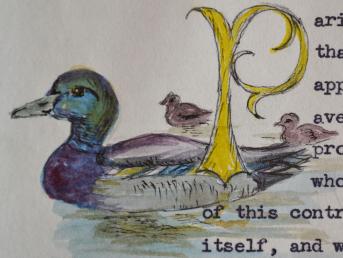
Parishioners of Trumpington may consider themselves lucky that they live at a place which opens up probably the best approach to the centre of the City of Cambridge. The avenue of trees in their constantly varying dress also provides access to walks of a varying pattern from those who still prefer walking as a pastime. For the purpose of this contribution we must ignore the short walks in the village itself, and with the War Memorial as a starting point the following routes are suggested.
(l) Moving off towards the centre of Cambridge take the Trumpington Road to Long Road, turn right and proceed to the foot of the railway bridge, turning left along Finch’s Walk at the point where Hobson’s Brook passes under the road. This walk takes us past Clare College sports ground on our right where the stream is bordered by gnarled willow trees and other tree and plant vegetation in a pleasing pattern. Ducks and their broods may also be seen in spring and early summer. Further along the stream at the end of the playing field the ‘non-stayers’ may turn left into Bentley Road and take the shorter course home, but the ‘stayers’ must continue along the stream past the allotments to the junction with Brooklands Avenue. The choice now is to turn left and return by the main road, or to continue across the main road to Coe Fen to Newnham and Grantchester Meadows, through part of the village of Grantchester and there join the road, crossing two streams back to our starting point. Although two miles further, the second choice is preferable, as the main road traffic noise is less restful and casual conversation is well nigh impossible. Returning by Bentley Road is a two-mile stretch, along the main road, three miles, and the full round through Grantchester is about five miles. Another route is of course to continue past Long Road turning right at Brooklands Avenue and return in the reverse direction, a further choice is to take the left path across Coe Fen and to follow the Newnham and Grantchester walk, which is about four miles.
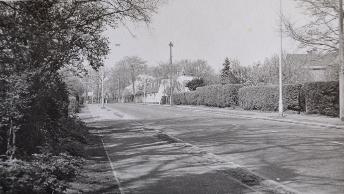
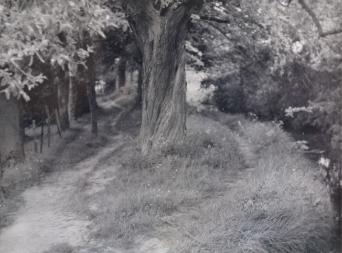
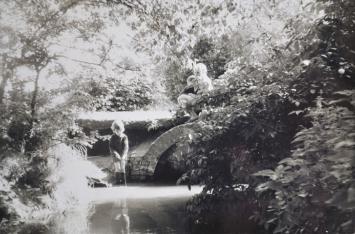
(2) To those folk who are in any doubt about their staying powers we suggest that a route through Church Lane past the parish Church and along Grantchester Road, joining the footpath through Grantchester Meadows is a good choice, as the final stages can be taken by bus at any point along Trumpington Road, but this of course is not to be recommended. For quiet reading in this connection may we recommend Rupert Brooke’s ‘Grantchester’. We must mention in passing that the diversion to Byron’s Pool should be taken at some stage either as a short walk from Grantchester Road and back to Trumpington on a warm afternoon, or as a break on a walk to Grantchester and back.
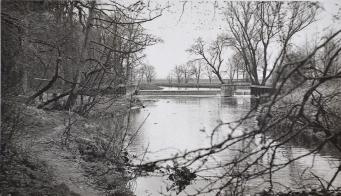
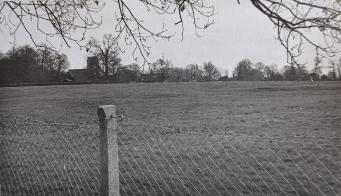
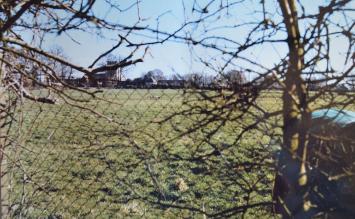
(3) For the energetic people out for the day we recommend a walk through Grantchester to the point at the corner where the footpath leaves in a south-westerly direction to Barton, along the newly made road to the Haslingfield turning, through Haslingfield and on to Harston, through the village to Hauxton Gap, and on along the main road back to Trumpington, a matter of eight or nine miles.
(4) We must not rule out the walk to Hauxton Gap, on to Little Shelford past the Church to Great Shelford and its Church, and home along the Shelford Road, a matter of five to six miles.
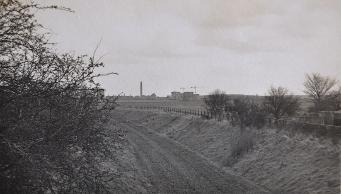
(5) People who value the open countryside should take the road past the Village Hall through the cut to Paget Road leaving Paget Close on the right towards the old Bedford line now closed and on across the main Cambridge/London main line to Red Cross Lane, turning left at the junction of Hills Road and Babraham Road, and on past the New Addenbrooke’s Hospital, returning by Long Road and Trumpington Road.
(6) The Ordnance Survey map published by the Cambridge Preservation Society in 1936 shows a path along a similar route through what is now Paget Road down to Hobson’s Brook, turning right immediately across the stream following the bank of the brook to Nine Wells Monument which can easily be seen from the railway trains passing down the main line. This path should continue to Granhams Road to the foot of the field adjoining Caius College Farm, turning right and returning by Shelford Road. We have not taken this walk for some years, but the route is clearly shown.
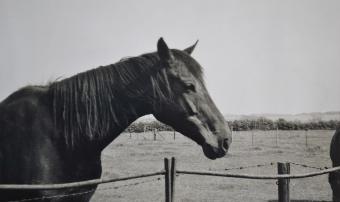
Weather
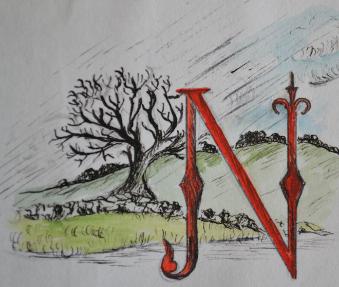
No Natural History survey would be complete without a record of the weather – that evergreen topic of conversation in Britain.
Perhaps time will prove that the 1969-70 weather pattern has not been other than average, but summarising this year’s record on a bitterly cold April day of intermittent sleet and snow one cannot help but feel we have been subjected to the worst winter ever! The general impression since last May is one of sudden changes and extremes of weather.
Very definitely it was noticed we could say – “Oak before Ash, we’re in for a splash!” Early summer brought alternating sunny days and torrential rains and for the first time ever Wimbledon was “washed out” on 23rd June, and nearly all the 3.25 ins. of rain in July fell on one day, 29th July. In spite of this it was a warm, dry summer – the warmest of the sixties – with some record high temperatures and a fine St. Swithin’s Day. Except for a break of duller, cooler weather during the last two weeks of August and the odd day or two, summer stretched into September and on to the end of October, giving us the sunniest and driest Autumn for years, with no more than a fraction of an inch of rain from September – mid November. There were bumper apple, pear and plum crops, the harvest was in early, but the light Trumpington soil was so dry and dusty our Autumn tidying up in the garden and Spring bulb planting had to be delayed. At this time some exceptionally beautiful sunsets were seen, so exceptional that the fact was reported on “Look East” news on television, this was due to the long dry sunny days at this time.
Winter came with a rush in November, with grey days, rain, frost, sleet and snow blizzards and very cold weather till Christmas week, which was almost Spring-like. The New Year started cold, but was generally mild till the second week in February when the severe weather returned proving that –
“If Candlemas day be fair and bright
Winter will have another flight.”
and it did! It was exceptionally sunny in February, but the bitter north winds stayed with us bringing sleet and snow storms – the heaviest of the year being as late as 4th March and it was a week before the last snowman had melted away. Day after day the biting winds and snow showers continued till on 8th April we had the coldest April night on record with the temperature down to 31° F.
At last on Tuesday 14th April, the temperature rose and by the week-end the prunus, almond and blackthorn were in full flower, the daffodils were out, the horsechestnut buds had burst out of their sticky, protective covering and a green haze was spreading over the hedges. Farmers were busy in the fields with tractors, gardeners spent a busy week-end. The miracle of Spring was on us; the world was alive again as Man and Nature worked overtime to compensate for the winter which had so long out-stayed its welcome.
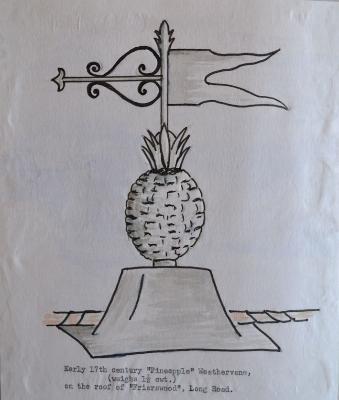
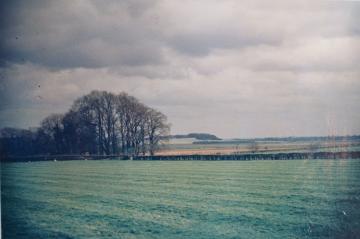
Endpiece

The compilers of this report are pleasantly surprised by the wealth and variety of wild life it reveals as existing in Trumpington in 1970. This is due in large measure to the steps which have been taken by the farmers and other sympathetic individuals to preserve habitats and maintain the necessary privacy for wild life to continue. This maintenance is important as a counterbalance to the increasing mechanical and material trappings of late 20th century living.
Yes, Trumpington has changed and we in 1970 wonder what it will look like here in 1980, 1990 and 2,000, or even 700 years hence – as this year in Pageant we look 700 years back to when Sir Roger set off for the Crusades. Will people still be able to wander in Byron’s Pool woods “far from the madding crowd”? Will the suggested Ring Road plans go through and surround us with a trunk road? What will have happened to the disused Oxbridge Railway Line which, regrettably, shows signs of becoming a rubbish dump?
Change there must be, but let us play our part in helping to ensure that Science goes hand in hand with Nature, that building and scientific development in agriculture may go forward without destroying what is good and beautiful in Nature.
June 1970
Mollie Bown
Enid Newell
Mary Pitman
Mary Woolf
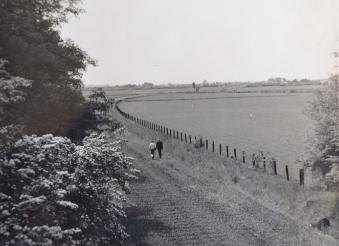
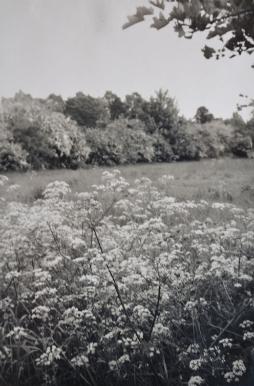
Acknowledgements
Mr. Antony Pemberton
Perse Prep. School
Dr. J. Rishbeth
Mr. H. G. Webster, River Farm
Mr. G. T. Martin, Glebe Farm
Mr. R. J. Cornwell, Clay Farm
Mr. T. Parsons, Anstey Hall Farm
Mr. S. J. Newell (Map)
Miss M. Smith [Mary Raeburn Smith] (Paintings)
Mr. M. Rayner (Photographs)
Mr. J. P. Bown “
Robert Dring “
Isabel Davidson “
2020 Transcription
Trumpington Women’s Institute, Janet Hendy
Editing and photographs, Andrew Roberts
OCR of source text, Howard Slatter